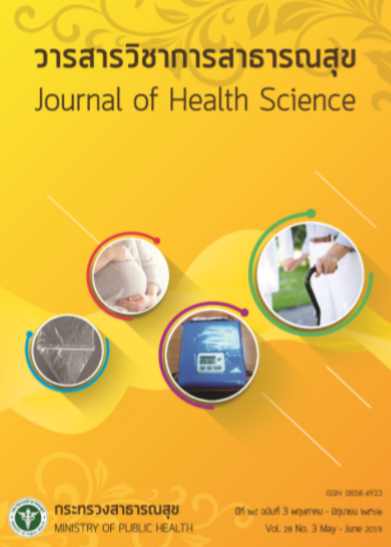Progression of Kidney Disease n Type 2 Diabetic Patients: a Case Study of Aranyaprathet Hospital
Keywords:
type 2 diabetic patient, kidney disease, disease progressionAbstract
This retrospective study aimed to investigate disease progression in different groups of patients and to compare risk factors and disease progression caused by kidney complications in two groups of type 2 diabetic patients: acetylsalicylic acid (ASA) users and non-ASA users. This research was a case control study whereby data were analyzed by comparing averages of ASA uses among type 2 diabetic patients in Aranyaprathet Hospital during 2011 and 2017, primarily based on 43 health data files system. The findings revealed that 69.7 percent of the patients were females and 36.3 percent aged between 56 and 75 years old. Slightly over half of the patients (51.1%) were those who began to develop diabetes in 2012. It was also found that 17.3% of the total patients smoked cigarettes, and 13.7 per cent were found addicted to local rice liquor. Moreover, 16.0% of the patients were found being affected only by type 2 diabetes, which was higher than those who were affected by the two diseases (type 2 diabetes and kidney disease) (p<0.05). Regarding the disease progression, the majority of patients were in the third phase and 37.0% were found having estimated glomerular filtration Rate (eGFR) at 30-59 mL/min/1.732. With respect to uses of ASA, patients were divided into two groups: those who took ASA (81 milligrams) and those who did not take ASA. It was found that the ASA users had relatively lower hemoglobin A1c (mean: 6.61, SD: 2.869) than the non-users (p<0.001). Thus, proactive policies should be initiated in order to avert kidney complications caused by type 2 diabetes. The healthcare service system should be also enhanced in order to seek those patients who have the risk of developing kidney complications. In addition, the medical staff in charge of healthcare maintenance should also stress the importance of healthcare promotion and regular home visits to the housebound patients should be made. This study also found that there was a correlation between smoking and the two groups of patients (i.e. those affected only by type 2 diabetes and those affected by type 2 diabetes and kidney diseases). The maximum number of cigarettes smoked per day was ten. This was primarily attributed to their health behaviors and social contexts. Alcohol drinking was also a major factor contributing to the risk of developing diabetes in both groups of patients. The amount of rice liquor drunk by the patients was classified into two patterns. The first pattern, which was known as “1-4 standard drink”, ranged from 2 to 9 bottle caps while the second, known as 5-11 standard drink, involved drinking 5-11 caps of rice liquor. Therefore, all responsible parties should be more concerned about social determinants of health which could be altered in order to reduce the number of patients. In addition, more qualitative and quantitative research studies in the field should be undertaken to uncover causes of the behaviors and provide guidance for behavior change.
Downloads
Downloads
Published
How to Cite
Issue
Section
License
Copyright (c) 2019 Journal of Health Science - วารสารวิชาการสาธารณสุข

This work is licensed under a Creative Commons Attribution-NonCommercial-NoDerivatives 4.0 International License.







